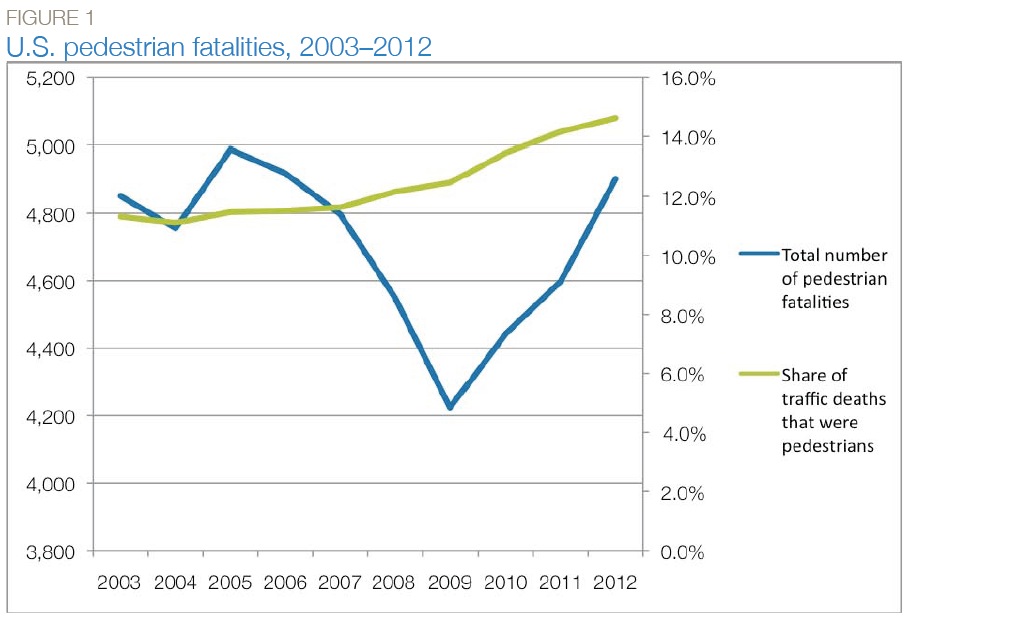SMART GROWTH AMERICA
Introduction
American communities are poised for a renaissance in walking. We’re walking more often, for fun and to get to places in our neighborhood. We turn to WalkScore.com when figuring out where to live and our most walkable places often are among the most economically vibrant in the country. Hundreds of cities have adopted Complete Streets policies to ensure walking is at the forefront of our decisions regarding street design. Public health organizations from the U.S. Centers for Disease Control and the Office of the Surgeon General to the local doctor’s office are encouraging us to get out for a walk for physical activity and to combat chronic disease. And indeed, we are walking: six out of 10 people walk for physical activity, and the share of adults who said they walk for transportation grew 6 percent from 2005 to 2010, according to the most recent data available. But we are still dealing with a legacy of roadways that fail to account for the safety of people on foot.
In the decade from 2003 through 2012, 47,025 people died while walking on our streets. That’s sixteen times the number of Americans who died in natural disasters—earthquakes, floods, hurricanes and tornadoes—over the last 10 years.
On top of that, an estimated 676,000 were injured—meaning someone on foot was hit by a car about every eight minutes.
Nationally, pedestrians represented 12.3 percent of total traffic deaths over this decade (see Figure 1 on page 2). After decreasing slightly in the first few years of the past decade, the fatality numbers have been rising more recently. A total of 4,280 people walking died in traffic crashes in 2010. That number increased to 4,432 in 2011, and 4,743 in 2012. In 2012, people on foot represented nearly 15 percent of all traffic fatalities (see Figure 1 on page 2).
When emphasizing safety and protective design for cars, we’ve witnessed improved safety. The number of drivers and passengers of vehicles who died in traffic crashes dropped by one third from 2003 to 2012. We realized this significant drop by focusing on vehicle design, encouraging and enforcing seat belt use, cracking down on drunk driving and curbing distracted driving— saving thousands of loved ones.
We have invested nowhere near the same level of money and energy in providing for the safety and security of people when they are walking.
While pedestrian deaths are labeled “accidents,” the data reviewed here indicate we can prevent the majority of them by taking deliberate steps, through better policy, design, practice and regulation—just as we have done with vehicular deaths. The majority of pedestrian deaths occur on arterial roadways, planned and engineered for speeding automobiles with little consideration for the diversity of people—young, old, with and without disabilities, walking and bicycling—who rely on these streets to get them from point A to point B. The lion’s share of these roadways were built with federal money and designed to federal specifications, so fixing the legacy of dangerous conditions undoubtedly will need to be a national project with federal support.
The urgent need to act is compounded by projected demographic changes. The nation’s older population will nearly double in size in the next 30 years. The number of racial and ethnic minorities is also projected to grow significantly. These groups, along with children, are disproportionately represented in pedestrian deaths.
Download full version (PDF): Dangerous By Design 2014
About Smart Growth America
www.smartgrowthamerica.org
“Smart Growth America advocates for people who want to live and work in great neighborhoods. We believe smart growth solutions support thriving businesses and jobs, provide more options for how people get around and make it more affordable to live near work and the grocery store. Our coalition works with communities to fight sprawl and save money. We are making America’s neighborhoods great together.”
Tags: Pedestrian, safety, Smart Growth America







 RSS Feed
RSS Feed